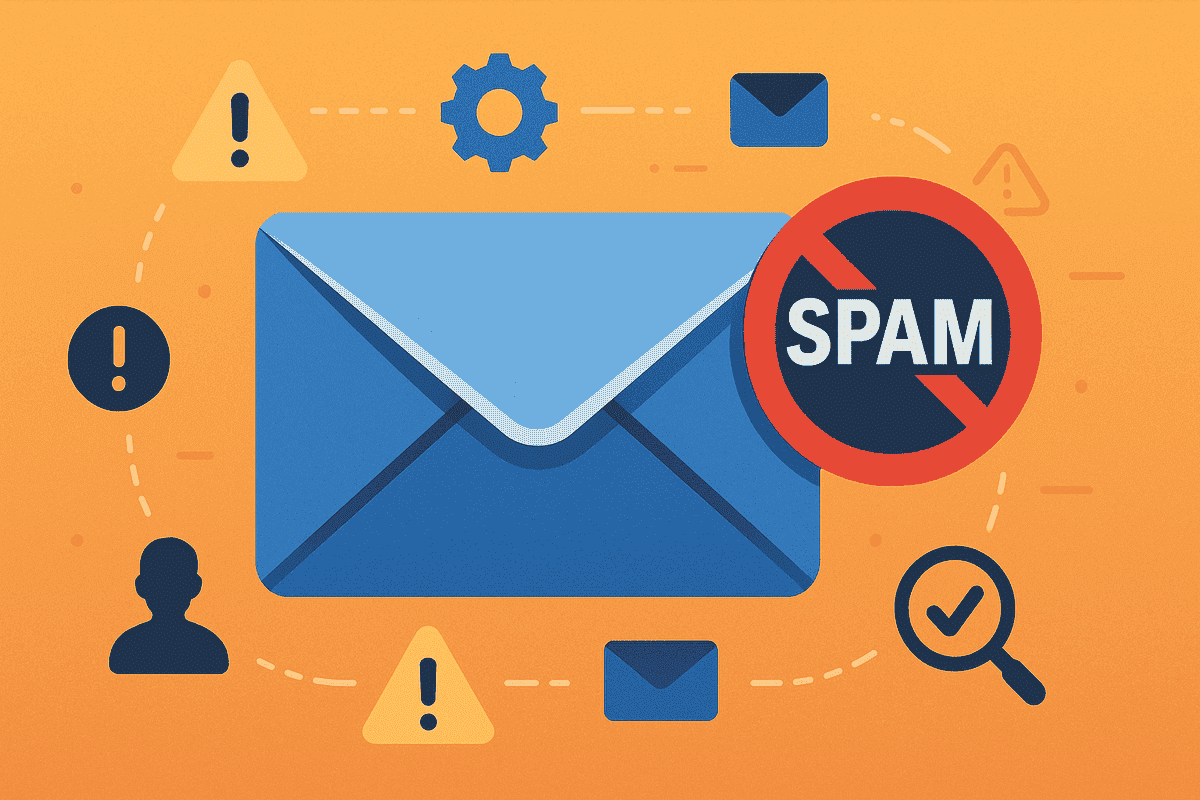"If an email isn't seen, it can't convert."
In 2025, that reality is harsher than ever: nearly 48% of B2B senders admit their biggest challenge is simply staying out of the spam folder.
I still remember Manny, a Philadelphia coffee-roaster who called me in a panic last fall. His limited-edition launch went to 7,200 subscribers…but his open rate crashed to 6%. Gmail had sidelined his "exclusive offer" in Promotions—and, worse, Outlook dumped it straight into junk. Sound familiar?
Why are perfectly legitimate emails still getting trapped, and what can you do—today—to escape? Let's dig in.
Why Email Deliverability Matters in 2025
Inbox providers now evaluate hundreds of signals—from sender reputation to AI-scored content tone. Studies show that 78% of consumers will hit "Report Spam" if an email merely looks suspicious.
For small businesses, every mis-deliverable message is lost revenue, wasted ad spend, and a dent in brand trust.
Glossary: The Must-Know Tech Terms
| Acronym | What It Stands For | Why You Need It |
|---|---|---|
| SPF | Sender Policy Framework | Authorizes the IPs allowed to send on your domain. |
| DKIM | DomainKeys Identified Mail | Adds a cryptographic signature so ISPs know the email is unaltered. |
| DMARC | Domain-based Message Authentication, Reporting & Conformance | Tells mailbox providers what to do if SPF/DKIM fail. |
| BIMI | Brand Indicators for Message Identification | Lets you show your verified logo in the inbox, boosting trust. |
| ARC | Authenticated Received Chain | Preserves authentication results during forwarding. |
7 Sneaky Reasons Your Emails Land in Spam
- Broken Authentication – Missing or mis-aligned SPF/DKIM/DMARC records.
- Cold-Start Domain – New domains without a reputation profile get sandboxed.
- List Neglect – High bounce or low engagement signals poor list hygiene.
- Spam-Trigger Content – ALL-CAPS subjects, deceptive preview text, or "too many $$."
- Unclear Consent Trail – Recipients never opted in, so complaints spike.
- Heavy Image-to-Text Ratio – Spam filters favor balanced, accessible code.
- Inconsistent From Name – Switching "Acme Deals" to "ACME Support" breeds distrust.
Quick win: Add a one-click "Keep emails out of spam" whitelist request to your welcome series.
The 6-Step Inbox Rescue Plan
| Step | Action | Outcome |
|---|---|---|
| 1. Authenticate & Align | Verify SPF, rotate DKIM keys, publish a DMARC policy, and apply BIMI. | ISPs confirm you're legit. |
| 2. Warm the IP/Domain | Start with small, engaged segments before full blasts. | Builds positive reputation signals. |
| 3. Purge & Segment | Remove hard bounces and 90-day inactive users; segment by behavior. | Higher engagement, lower complaints. |
| 4. Personalize at Scale | Dynamic subject lines and product blocks, fed by purchase data. | 1:1 relevance lifts opens and clicks. |
| 5. Run Pre-flight Tests | Use seed-list tools to preview placement and spam-score. | Catch issues before the real send. |
| 6. Monitor & Iterate | Track inbox vs. spam placement weekly; adjust cadence, content, and authentication. | Sustained deliverability health. |
Case Study: CoffeeCo's Deliverability Comeback
Problem: CoffeeCo's monthly newsletter hit Gmail's Promotions tab, slashing open rates from 42% to 6%.
Fix Implemented:
- Enabled SPF, DKIM, and record-only DMARC.
- Segmented the top 20% clickers, warmed domain for 10 days.
- Swapped "Flash Sale!!!" subject for "First-dibs on Guatemala Huehuetenango."
- Added BIMI logo.
Result: Inbox placement jumped to 92% and revenue per email grew 38% within one month.
2025 Trends & Predictions
- AI-Adaptive Filters – ISPs now weigh "reader satisfaction" time-on-email metrics.
- Stricter Engagement Thresholds – Expect Gmail to throttle senders with under 10% opens.
- Mandatory One-Click Unsubscribe – Bulk senders lacking it risk blanket spam filtering.
- Brand Logos as Trust Signals – BIMI adoption becomes table stakes.
- Zero-Party Data Supremacy – Consent based on preferences, not just email address.
Tools & Resources
Google Postmaster Tools
Diagnose reputation & complaint levels.
ZeroBounce
Validate addresses; monitor list health.
MailGenius
Pre-send spam tests.
Litmus
Cross-client rendering & QA.
Validity Everest
Deliverability analytics & inbox monitoring.
Myths & FAQ
Common Myths
Myth #1 – "If I buy a list, no one will notice."
Buying lists skyrockets complaint rates and can blacklist your domain overnight.
Myth #2 – "Images guarantee better engagement."
One huge hero image often hurts deliverability; balance text for accessibility.
FAQ
Why do my Gmail emails skip the inbox but Outlook delivers fine?
Gmail's AI filters weigh engagement harder; low opens trigger Promotions or spam.
Does DMARC alone stop spam issues?
DMARC prevents spoofing but doesn't fix poor engagement or bad content.
How often should I clean my list?
At least quarterly—or every 30 days if sending daily.
Will sending more frequently improve placement?
Only if engagement stays high; otherwise, you'll harm reputation.
What subject-line length is safest?
Aim for 35–50 characters with a clear value proposition.
Conclusion & Next Steps
Almost half of legitimate business emails still miss the inbox—but your messages don't have to. By authenticating your domain, respecting subscriber preferences, and monitoring engagement like a hawk, you'll turn the spam folder from a silent killer into a non-issue.
Ready to rescue your revenue? Start with Step 1 today, then tell me in the comments: Which fix will you implement first?

